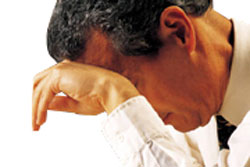- What is Cluster Headache
- Statistics on Cluster Headache
- Risk Factors for Cluster Headache
- Progression of Cluster Headache
- Symptoms of Cluster Headache
- Clinical Examination of Cluster Headache
- How is Cluster Headache Diagnosed?
- Prognosis of Cluster Headache
- How is Cluster Headache Treated?
- Cluster Headache Prevention
- Cluster Headache References
What is Cluster Headache

Cluster headache is related to other headache syndromes, including:
- Paroxysmal hemicranias: Headaches that occur daily, on multiple occasions throughout the day, and typically produce throbbing pain on one side, often behind the eye;
- Hemicrania continua: A type of headache that produces continuous pain which varies in severity. Pain always occurs on the same side of the head; and
- Other rare headache types.
Statistics on Cluster Headache
Various studies have estimated the prevalence of cluster headaches to be between 56 and 401 cases per 100,000 people. The best available evidence shows that 124 people per 100,000 will experience cluster headaches at some point in their life, and 53 people per 100,000 will experience these headaches in any given year.
Men are more likely to experience cluster headaches than women. The male to female ratio is 4.3:1, and men are even more likely to experience chronic cluster headaches compared to women (ratio 15:1). Middle-aged men are the most likely to be affected. Cluster headaches occur rarely in children.
Risk Factors for Cluster Headache
Cluster headache is a predominantly male disease. Cluster headaches are also thought to have a genetic component as individuals with a family history of the disorder have a slightly higher risk. Individuals with a history of head injury also have an increased risk of experiencing cluster headache, although there may be a significant lag between injury and onset of cluster headaches.
Other factors that have been associated with cluster headaches include:
- Alcohol consumption;
- Caffeine consumption;
- Smoking;
- Stress;and
- Low testosterone levels.
Progression of Cluster Headache

Cluster headaches may be experienced as frequently as 8 times per day or, in less frequent cases, every 2 days. Clusters of headaches typically last for 2–12 weeks at a time, followed by periods of remission in which headaches do not occur. Headache clusters may recur as often as 2–3 times per year or as infrequently as every 2–3 years. The headaches are generally severe but brief, lasting 15–180 minutes.
Symptoms of Cluster Headache
The pattern of symptoms associated with cluster headache is very specific and differs from the pattern associated with migraine headaches, which may also occur in clusters. The timing, frequency and duration of headaches are the key defining features and the doctor will usually make a diagnosis based on symptoms alone.
This type of headache occurs as clusters of frequent headaches that typically last for weeks or months, separated by periods of remission which may last for months or years, in which no headaches occur. However, 10–15% of people with this headache syndrome will experience unremitting clusters of headaches.
Within a cluster of headaches, a person must experience headaches with specific characteristics (determined by the International Headache Society) to receive a diagnosis of cluster headache. These characteristics are:
- A history of at least 5 attacks that fulfil all of criteria 2–5;
- Headaches with the following pain characteristics:
- Severe to very severe unilateral (one-sided) pain;
- Orbital (in the cavity of the eyeball), supra-orbital (facial) or temporal (at the side of the head) pain;
- Pain duration of 15–180 minutes;
- Headaches associated with cranial autonomic symptoms (symptoms affecting the head, regulated by the autonomic nervous system) which are always ipsilateral (on the same side) and include at least one of the following:
- Headaches occur as frequently as 8 times per day or as infrequently as once in 2 days;
- Headaches are not attributable to another condition such as an infection or illness.
While the majority of individuals with cluster headaches experience one or more cranial autonomic symptoms, a diagnosis of cluster headache may also be made in an individual who does not experience these symptoms but reports feeling restless or agitated during a headache attack. Unlike people who experience migraine headaches who typically feel the need to rest during an acute attack, those with cluster headaches are more prone to pacing when they experience an acute headache. Another distinguishing feature of cluster headaches is the regularity with which they occur. Many individuals report headaches occurring at the same time each day, like an alarm clock, or at the same time each year. Many people affected by cluster headaches experience their headaches during the first phase of rapid eye movement sleep each night.
While the one-sided pain of cluster headaches is also a feature of migraines, the disorders are distinct headache syndromes. Cluster headaches do not typically produce symptoms such as aura (visual disturbance), photophobia (sensitivity to light) and nausea like migraine headaches. However, some people with cluster headaches do experience these symptoms and recent evidence suggests they are much more common in cluster headaches than previously thought. For example, one study reported that 14% of cluster headache patients experienced accompanying aura, and 56% and 43% experienced photophobia and phonophobia (sensitivity to sound) respectively.
The quality of pain associated with cluster headaches is also distinct and the following characteristics are typical:
- Severe pain which may cause awakening from sleep;
- Unilateral pain behind one eye which feels like a red hot poker, and typically occurs on the same side. However, in one study of individuals with cluster headaches, 14% reported the pain changed side during an attack and 18% reported experiencing pain on different sides of the head during individual headaches;
- Rapid onset of pain, which reaches its peak within 15 minutes.
The headaches may be further classified according to the timing of clusters as:
- Episodic: When clusters have a duration of 7 days to 1 year and are separated by remission periods of > 1 month;
- Chronic: When clusters have a duration > 1 year and occur with remission periods < 1 month.
Clinical Examination of Cluster Headache

A clinical examination may also be conducted to rule out secondary diagnoses if another condition such as infection is possibly causing the headaches.
How is Cluster Headache Diagnosed?
A diagnosis of cluster headache can usually be made on the basis of clinical history (asking about headache symptoms) and examination. Further tests will only be conducted if your doctor suspects another medical condition is causing the headache.
Prognosis of Cluster Headache
Although the condition is not well understood, cluster headache is thought to be a lifelong condition for most people. Available evidence suggests that about 10% of those who experience episodic cluster headaches will progress to more frequent, chronic cluster headaches, while approximately one-third of chronic cluster headache sufferers will experience headaches less frequently and transform to episodic clusters.
How is Cluster Headache Treated?

- Prophylactic therapy: Preventing or reducing the frequency of attacks;
- Abortive therapy: Terminating the attack when it occurs; or
- Surgical therapy.
Prophylaxis
Prophylactic measures (discussed above) are vital, as medications have limited efficacy for aborting a cluster headache.
Abortive therapy
Abortive therapy can be challenging due to the rapid onset and severity of pain that characterises cluster headaches. Highly effective medications which exert a headache-relieving effect very quickly and are well absorbed are required for optimal pain relief. Unfortunately, medicines that meet these criteria have not yet been developed, and all medicines used in the treatment of cluster headache provide suboptimal pain relief. However, several medications and other therapies have been demonstrated effective in relieving pain associated with cluster headaches.
Oxygen therapy
Oxygen therapy is the administration of highly concentrated oxygen through a breathing mask, nasal prongs or a tube. Some people with cluster headaches may respond to high-dose, high-flow oxygen therapy alone, although the mechanisms by which oxygen relieves cluster headache pain are not well understood. Oxygen therapy is not associated with any adverse effects, making it suitable for use several times daily. In comparison, medicines for abortive treatment of cluster headache can be used a maximum of twice per day.
One study reported that 56% of patients achieved pain relief with 15 minutes of oxygen therapy. Individuals who respond well to oxygen therapy may benefit from purchasing an oxygen cylinder so that they can institute therapy at home. However, those who experience facial pain as a symptom of cluster headache may not be able to use an oxygen mask because it exacerbates facial pain. Those who use oxygen at home must take fire precautions (e.g. avoid smoking) as oxygen is highly combustible.
Hyperbaric oxygen therapy, or breathing pure oxygen in a pressurised room, is best known as a treatment for decompression sickness (e.g. after scuba diving). There is limited evidence regarding its use in the treatment of cluster headaches, although one study reported 7 of 8 individuals with cluster headaches achieved pain relief with 5 minutes of hyperbaric oxygen therapy. Unfortunately, unlike oxygen therapy, this treatment is associated with adverse effects including damage to the ears, sinuses and lungs.
Pharmacotherapy
For those who require prophylactic medication, there are several possible alternatives:
- Sumatriptan subcutaneous injection (injected under the skin) administered during an acute episode is effective in reducing the severity and duration of cluster headaches; however, it takes several minutes to act. The cost of the medicine may limit its use, particularly if daily injections are required;
- Sumatriptan nasal spray administered during an acute episode is effective in reducing the severity and duration of cluster headaches. A 12 mg dose of sumatriptan is more effective than a 6 mg dose. However, the nasal spray takes longer to be absorbed by the body and exert a pain relief effect compared to subcutaneous administration (15 versus 30 minutes);
- Zolmitriptan nasal spray is effective in reducing the severity and duration of cluster headaches when administered after headache onset. A 10 mg dose of zolmitriptan is more effective than a 5 mg dose. Studies have reported up to 25% of individuals achieve pain relief within 10 minutes of administration, and up to 63% do so within 30 minutes of administration;
- Zolmitriptan tablet is effective in aborting episodic cluster headaches but there is no evidence for its use in chronic cluster headaches. It takes about 30 minutes to exert an effect. A 10 mg dose is more effective than a 5 mg dose;
- Octreotide subcutaneous injection is considered an effective abortive treatment for cluster headache. However, octreotide therapy takes around 30 minutes to act.
Typically the medications are administered at the onset of an attack. For individuals whose cluster headaches occur at predictable times (e.g. a person who is woken by headache at the same time each night), dihydroergotamine or zolmitriptan tablets may be taken 1–2 hours prior to the expected headache.
Surgical therapy
Surgical treatments are reserved for individuals with cluster headaches which are not relieved by treatment with acute medicines.
Microvascular decompression of cranial nerve V
Microvascular decompression of cranial nerve V is a surgical procedure to relieve pain caused by a blood vessel abnormally positioned so that it compresses cranial nerve V (the nerve that regulates pain in the face). This involves opening the skull in a surgical procedure called craniotomy, and inserting a small sponge between the nerve and the compressing blood vessel to achieve decompression. In one study, 47% of patients with chronic cluster headache achieved long-term (5-year) pain relief with microvascular decompression of cranial nerve V.
Ipsilateral deep brain stimulation
Ipsilateral deep brain stimulation is a therapy in which an electrode is implanted in the brain near the hypothalamus to enable deep brain stimulation. It is an option for individuals who do not achieve relief with pharmacotherapy. This is an emerging treatment and evidence regarding its effectiveness is still being generated. Early results are promising: one study reported 61% of individuals treated for cluster headache experienced pain relief with the therapy. However, ongoing treatment is required and there is a 3 month delay between commencement of treatment and pain relief.
Occipital nerve stimulation
Occipital nerve stimulation involves surgery to implant an electric device in the base of the skull. The device is then used to stimulate the occipital nerve with electrical impulses. This therapy was reported as an effective treatment in individuals whose cluster headaches did not respond to pharmacotherapy. The majority of patients (10/14) reported improvement with this therapy.
More information
 |
For more information on headaches and migraines, including types of headaches, treatments for headaches, and some useful tools and videos, see Headaches and Migraines. |
 |
Headache Australia is the only Australian charity that aims to support the more than 5 million Australians affected by headache and migraine. Headache Australia is an initiative of the Brain Foundation – a national charity raising funds for research from community donations. |
For more information, see Headache Australia.
Cluster Headache Prevention
Prophylactic medicines
As there are no medications available that rapidly and effectively treat cluster headache pain, prophylaxis (prevention) is the best management strategy. For individuals with chronic cluster headaches with no remission period, many medications are unsuitable and management is more challenging. A range of medications may be used and all have relative advantages and disadvantages. Using too much of any of these medications is dangerous and may worsen rather than relieve headache. Always use the dose prescribed by your doctor.
Medications which may be prescribed for the prevention of cluster headaches include:
- Verapamil with prednisolone, with the dose of verapamil increasing over time and the prednisolone dose decreasing and eventually being weaned over the course of treatment;
- Prednisolone alone is effective in preventing headaches in most cases; however, a high dose is required which makes this medicine unsuitable for long-term treatment. Headaches typically recur when the dose is reduced. As this medicine acts quickly, it may be used in conjunction with other slower-acting medicine as initial treatment;
- Verapamil is considered more effective than other treatments such as lithium, though high doses are typically required. ECG monitoring of the heart is considered mandatory while this medicine is being taken;
- Greater occipital nerve injections of betamethasone plus lignocaine are considered effective prophylaxis for episodic cluster headaches. The occipital nerve is the nerve that supplies the back of the head. Headaches recur within 2 months in approximately one-third of people who use this treatment. The remaining two-thirds achieve headache relief for 4–26 months;
- Lithium is effective in treating cluster headache, though to a lesser degree than verapamil. It is also associated with serious side effects which mean it is less safe that verapamil. Lithium appears to be more effective in individuals with chronic compared to episodic cluster headaches;
- Testosterone replacement therapy: One small study reported that testosterone replacement therapy was effective in relieving cluster headaches in more than half of male patients who had tried and failed to achieve headache relief with other treatments.
Currently there is insufficient evidence for the use of other medicines as prophylaxis for cluster headaches.
Lifestyle measures
Although lifestyle changes cannot stop cluster headaches occurring, many people will benefit from incorporating lifestyle measures into their treatment plan. Avoiding alcohol and foods associated with cluster headaches may be beneficial for some, as may avoiding smoking. Adopting a healthy lifestyle (e.g. performing regular exercise and maintaining regular sleeping and eating routines) may also be beneficial, as may avoiding stress and tension which may trigger attacks.
Cluster Headache References
- Matharu M. Cluster headache. BMJ Clin Evid. 2010;2:1212. [Abstract]
- The international classification of headache disorders, 2nd edition [online]. Oxford, UK: International Headache Society; May 2005 [cited 8 November 2011]. Available from: [URL link]
- Stark R. How to treat: Severe headache. Aus Doctor. 2005;29-34. [Full text]
- Fischera M, Marziniak M, Gralow I, Evers S. The incidence and prevalence of cluster headache: A meta-analysis of population-based studies. Cephalalgia. 2008;28(6):614-8. [Abstract]
- Stillman MJ. Testosterone replacement therapy for treatment refractory cluster headache. Headache. 2006;46(6):925-33. [Abstract]
- Matharu MS, Zrinzo L. Deep brain stimulation in cluster headache. Expert Rev Neurother. 2011;11(4):473-5. [Full text]
- Beck E, Sieber WJ, Trejo R. Management of cluster headache. Am Fam Physician. 2005;71(4):717-24. [Abstract | Full text]
- Simon H. Cluster headache [online]. Baltimore, MD: University of Maryland Medical Center; 9 September 2008 [cited 17 January 2012]. Available from: [URL link]
- Clinch CR. Evaluation of acute headaches in adults. Am Fam Physician. 2001;63(4):685-92. [Abstract | Full text]
- Burns B, Watkins L, Goadsby PJ. Treatment of intractable chronic cluster headache by occipital nerve stimulation in 14 patients. Neurology. 2009;72(4):341-5. [Abstract]
- Rozen TD. Interventional treatment for cluster headache: A review of the options. Curr Pain Headache Rep. 2002;6(1):57-64. [Abstract]
- Lewis DW. Headaches in children and adolescents. Am Fam Physician. 2002;65(4):625-32. [Abstract | Full text]
- Schoenen J. Cluster headache. Adv Studies Med. 2001;1(11):446-8. [Full text]
- Cluster headache [online]. London, UK: National Health Service; 2001 [cited 17 January 2012]. Available from: [URL link]
- Prednisolone [online]. Dundee, UK: NHS Tayside; 2006 [cited 17 January 2012]. Available from: [URL link]
- Health care guideline: Diagnosis and treatment of headache [online]. Bloomington, MN: Institute for Clinical Systems Improvement; January 2011 [cited 17 January 2012]. Available from: [URL link]
All content and media on the HealthEngine Blog is created and published online for informational purposes only. It is not intended to be a substitute for professional medical advice and should not be relied on as health or personal advice. Always seek the guidance of your doctor or other qualified health professional with any questions you may have regarding your health or a medical condition. Never disregard the advice of a medical professional, or delay in seeking it because of something you have read on this Website. If you think you may have a medical emergency, call your doctor, go to the nearest hospital emergency department, or call the emergency services immediately.







